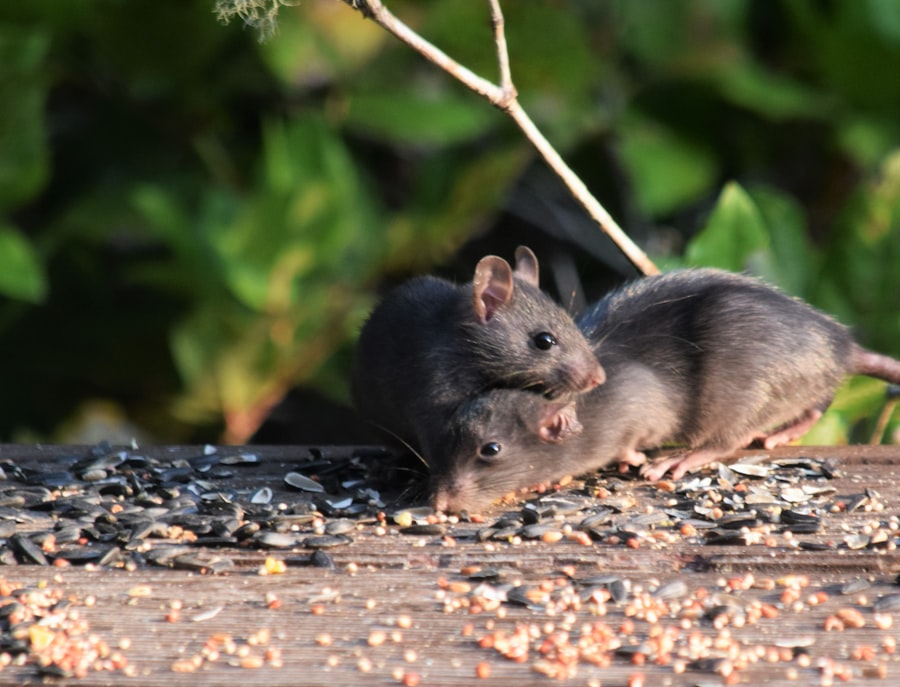Rodent infestations can be a significant nuisance for homeowners, often leading to property damage and health concerns. Recognizing the signs of these unwelcome guests is the first step in addressing the issue. Common indicators include droppings, gnaw marks, and nests.
Rodent droppings are typically small, dark, and pellet-shaped, often found in areas where food is stored or along walls. Additionally, homeowners may notice gnaw marks on furniture, walls, or food packaging, which indicate that rodents are actively seeking food sources. Nests, often made from shredded paper, fabric, or insulation, can be found in hidden corners or behind appliances.
Another telltale sign of a rodent problem is the presence of strange noises. Mice and rats are nocturnal creatures, so homeowners may hear scratching or scurrying sounds in the walls or ceilings during the night. These sounds can be alarming and are often accompanied by a sense of unease about what might be lurking nearby.
Furthermore, a musty odor may permeate the area where rodents are nesting, as their urine and droppings can create an unpleasant smell. By being vigilant and aware of these signs, homeowners can take action before the infestation escalates.
Key Takeaways
- Identifying signs of rodent infestation includes droppings, gnaw marks, and strange noises in the walls.
- Prevention tips include sealing cracks and holes, keeping food tightly sealed, and maintaining a clean home.
- Effective methods for removing rodents include traps, baits, and natural deterrents like peppermint oil.
- Calling in professional exterminators may be necessary for severe infestations or recurring problems.
- Rodent-proofing your home involves keeping a tidy yard, storing firewood away from the house, and sealing outdoor entry points.
Prevention is Key: Tips for Keeping Mice and Rats Out of Your Home
Preventing a rodent infestation is far more effective than dealing with one after it has taken hold. Homeowners can take several proactive measures to keep mice and rats at bay. One of the most crucial steps is sealing entry points.
Rodents can squeeze through surprisingly small gaps, so it is essential to inspect the home for cracks in walls, gaps around windows and doors, and holes in the foundation. Using materials like steel wool or caulk can effectively block these entryways, making it much harder for rodents to gain access. In addition to sealing entry points, maintaining cleanliness is vital in deterring rodents.
Food sources should be stored in airtight containers, and crumbs should be promptly cleaned up to eliminate potential attractants. Regularly taking out the trash and ensuring that outdoor garbage bins are securely closed can also help reduce the likelihood of attracting rodents. Furthermore, keeping clutter to a minimum both indoors and outdoors can eliminate hiding spots for these pests.
By implementing these preventive measures, homeowners can significantly reduce their chances of experiencing a rodent infestation.
Getting Rid of Rodents: Effective Methods for Removing Mice and Rats

When faced with a rodent infestation, it is essential to act quickly and effectively to eliminate the problem. There are various methods available for removing mice and rats from a home. Traps are one of the most common solutions, with options ranging from traditional snap traps to more humane catch-and-release traps.
Snap traps are designed to kill rodents quickly, while catch-and-release traps allow homeowners to capture the animals alive and release them far from their property. Regardless of the type of trap chosen, it is crucial to place them strategically in areas where rodent activity has been observed. In addition to traps, some homeowners may opt for rodenticides—poisons specifically designed to kill rodents.
While these can be effective, they come with risks, particularly if there are pets or children in the home. It is essential to follow all safety guidelines when using rodenticides and consider consulting with a pest control professional for advice on their use. Ultimately, the choice of method will depend on the severity of the infestation and personal preferences regarding humane treatment.
DIY vs Professional Help: When to Call in the Exterminators
| Factors | DIY | Professional Help |
|---|---|---|
| Cost | Low | High |
| Time | Variable | Quick |
| Effectiveness | Variable | High |
| Safety | Depends on product | Professional handling |
| Extent of Infestation | Small to moderate | Large |
Deciding whether to tackle a rodent infestation independently or seek professional help can be challenging for homeowners. For minor infestations or early signs of rodent activity, DIY methods may suffice. Setting traps and sealing entry points can often resolve the issue without incurring significant costs.
However, if the infestation is extensive or if there are concerns about health risks associated with rodents, it may be time to call in professional exterminators. Professional pest control services have access to advanced techniques and products that are not available to the average homeowner. They can conduct thorough inspections to identify the extent of the infestation and determine the best course of action.
Additionally, professionals are trained to handle hazardous materials safely and can provide long-term solutions that address not only the current problem but also potential future infestations. Ultimately, weighing the severity of the situation against personal comfort levels with DIY methods will guide homeowners in making this important decision.
Rodent-Proofing Your Home: Steps to Take to Prevent Future Infestations
Once a rodent infestation has been dealt with, it is crucial for homeowners to take steps to prevent future occurrences. Rodent-proofing a home involves a combination of sealing entry points and making environmental changes that deter rodents from returning. As previously mentioned, sealing gaps and cracks is essential; however, it is equally important to regularly inspect these areas for new vulnerabilities that may arise over time.
In addition to physical barriers, homeowners should consider landscaping changes that discourage rodents from approaching their property. Keeping shrubs and trees trimmed away from the house can reduce potential pathways for rodents to access roofs or attics. Furthermore, maintaining a tidy yard by removing debris and keeping firewood stacked away from the home can eliminate potential nesting sites.
By taking these proactive measures, homeowners can create an environment that is less inviting to rodents.
Health Risks and Concerns: Understanding the Dangers of Rodent Infestations

Diseases Transmitted by Rodents
For instance, hantavirus is transmitted through contact with rodent droppings or urine and can lead to severe respiratory issues. Similarly, leptospirosis is another disease associated with rodent infestations that can cause flu-like symptoms and even liver damage in severe cases.
The Impact on Allergies and Asthma
Beyond direct disease transmission, rodents can also exacerbate allergies and asthma symptoms due to their droppings and dander. The presence of rodents in a home can lead to increased indoor allergens that affect vulnerable individuals.
The Importance of Prompt Action
Therefore, addressing rodent infestations promptly is not only about protecting property but also about safeguarding health and well-being.
Rodent Control in Outdoor Spaces: Managing Mice and Rats in the Yard and Garden
Rodents do not limit their activities to indoor spaces; they can also wreak havoc in outdoor areas such as yards and gardens. Managing rodent populations outside requires a different approach than dealing with indoor infestations. One effective strategy is to create an environment that is less conducive to rodent habitation.
This includes keeping gardens well-maintained by removing fallen fruits or vegetables that may attract rodents. Additionally, homeowners should consider using natural deterrents such as planting certain herbs—like mint or lavender—that are known to repel rodents. Installing fencing around gardens can also provide a physical barrier against these pests.
Furthermore, ensuring that compost bins are securely closed can prevent rodents from accessing food scraps that might otherwise lure them into outdoor spaces.
Maintaining a Rodent-Free Home: Tips for Long-Term Prevention and Management
Maintaining a rodent-free home requires ongoing vigilance and proactive management strategies. Regular inspections of both indoor and outdoor spaces should become part of a homeowner’s routine maintenance checklist. This includes checking for new entry points or signs of rodent activity and addressing any issues immediately before they escalate.
In addition to inspections, homeowners should establish good habits regarding cleanliness and waste management. Regularly cleaning kitchens and dining areas will help eliminate food sources that attract rodents. Moreover, educating family members about proper food storage practices can further enhance prevention efforts.
By fostering an environment that prioritizes cleanliness and vigilance, homeowners can significantly reduce their risk of future rodent infestations while enjoying peace of mind in their living spaces.
If you’re dealing with a rodent infestation in your home, you may want to consider implementing some DIY accent wall ideas to transform your space and boost your home’s style and value. Creating a visually appealing environment can help deter rodents from making themselves at home. Check out this article on DIY accent wall ideas for inspiration on how to spruce up your living space while also addressing your rodent problem.
FAQs
What are rodents (mice or rats)?
Rodents are small mammals that belong to the order Rodentia. They are characterized by their continuously growing incisors and make up the largest group of mammals, with over 2,000 species.
What are the differences between mice and rats?
Mice are generally smaller than rats, with a slender body, pointed snout, and large ears. Rats are larger, with a more robust body, blunt snout, and smaller ears. Behaviorally, rats tend to be more cautious and less curious than mice.
Where do rodents (mice or rats) live?
Rodents can be found in various habitats, including urban areas, fields, forests, and agricultural lands. They are adaptable and can thrive in a wide range of environments.
What do rodents (mice or rats) eat?
Rodents are omnivorous and will eat a variety of foods, including grains, fruits, vegetables, insects, and even small animals. They are known to be opportunistic feeders and will consume whatever is readily available.
What are the health risks associated with rodents (mice or rats)?
Rodents can carry and transmit various diseases to humans, including hantavirus, leptospirosis, and salmonellosis. They can also contaminate food and cause damage to property with their gnawing and nesting behaviors.
How can I prevent rodents (mice or rats) from entering my home?
To prevent rodents from entering your home, it is important to seal any cracks or openings in the foundation, walls, and roof. Keep food stored in airtight containers, maintain cleanliness, and remove any potential nesting sites. Additionally, consider using traps or contacting a pest control professional if an infestation occurs.






